Roskilde Domkirke
( Roskilde Cathedral )Roskilde Cathedral (Danish: Roskilde Domkirke), in the city of Roskilde on the island of Zealand (Sjælland) in eastern Denmark, is a cathedral of the Lutheran Church of Denmark.
The cathedral is the most important church in Denmark, the official royal burial church of the Danish monarchs, and a UNESCO World Heritage Site. This is due to two criteria: the architecture of the cathedral shows 800 years of European architectural styles, and it is one of the earliest examples in Scandinavia of a Gothic cathedral to be built in brick; it encouraged the spread of the Brick Gothic style throughout Northern Europe. Constructed during the 12th and 13th centuries, the cathedral incorporates both Gothic and Romanesque architectural features in its design. The cathedral has been the main burial site for Danish monarchs since the 15th century. As such, it has been significantly extended and altered over the centuries to accommodate a considerable number of bu...Read more
Roskilde Cathedral (Danish: Roskilde Domkirke), in the city of Roskilde on the island of Zealand (Sjælland) in eastern Denmark, is a cathedral of the Lutheran Church of Denmark.
The cathedral is the most important church in Denmark, the official royal burial church of the Danish monarchs, and a UNESCO World Heritage Site. This is due to two criteria: the architecture of the cathedral shows 800 years of European architectural styles, and it is one of the earliest examples in Scandinavia of a Gothic cathedral to be built in brick; it encouraged the spread of the Brick Gothic style throughout Northern Europe. Constructed during the 12th and 13th centuries, the cathedral incorporates both Gothic and Romanesque architectural features in its design. The cathedral has been the main burial site for Danish monarchs since the 15th century. As such, it has been significantly extended and altered over the centuries to accommodate a considerable number of burial chapels and the many added chapels show different architectural styles.
The cathedral is a major tourist attraction, bringing in over 165,000 visitors annually. Since 1995, it has been listed as a UNESCO World Heritage Site due to its unique architecture. A working church, it also hosts concerts throughout the year.
 The cathedral seen from the Bispegården (Bishop's house).
The cathedral seen from the Bispegården (Bishop's house). Christian IX's Chapel (right) and Frederik IX's Burial Site (left).Previous churches
Christian IX's Chapel (right) and Frederik IX's Burial Site (left).Previous churches
Roskilde was named the new capital of Denmark by King Harald Bluetooth around the year 960. The king had previously resided in Jelling, where he built a church and raised the Jelling stones, but after uniting the Danes and Norwegians, a move was necessary to enable the monarch to stay close to the centre of power in the new kingdom. According to written sources, when moving to Roskilde, Bluetooth built a royal farm and next to it, a small stave church, dedicated to the Holy Trinity. Little is known of the Trinity Church, let alone its architecture, but despite its brief history at least two events are known to have taken place. In Adam of Bremen's Gesta Hammaburgensis ecclesiae pontificum, there is an account of how the king's son, Sweyn Forkbeard, raised a rebellion against him, forcing him to flee to Jomsborg. When Bluetooth died in 985/986, the army that had been raised against him brought his body to Roskilde and buried him in the church he had built.[1] At Christmas in 1026, Ulf the Earl was murdered by one of Cnut the Great's housecarls. Though the sources differ, this happened either inside the church (Chronicon Roskildense) or at the royal farm (Saxo Grammaticus's Gesta Danorum). Ulf had been married to Cnut the Great's sister Estrid, who was outraged by the murder and demanded a weregild.[2]
There is some doubt as to when Roskilde became the seat of the Bishop of Roskilde. When Sweyn Forkbeard conquered England in 1013, he began sending English bishops to Denmark, a process which was continued by his successor Cnut the Great. This caused some conflict with the Archbishop of Hamburg, who regarded Scandinavia as belonging to the Archdiocese of Bremen. The earliest known bishop of Roskilde was Gerbrand, who had been a cleric with Cnut the Great, and who was intercepted by the Archbishop of Hamburg-Bremen's men when he sailed to Denmark in 1022. Only after swearing allegiance to the archbishop was he allowed to continue his journey. The archbishop may have had good reason to be suspicious, as documents of the time suggest that Cnut the Great may have planned to create an archdiocese in Roskilde, with Gerbrand as archbishop.[3]
Funded by the weregild Estrid Svendsdatter had received, the old Trinity Church was torn down and construction of a simple stone cathedral began around 1026. This may have formed the base of the later travertine cathedral, but it is difficult to tell, as two cathedrals have subsequently been built on the same site. However, an archaeological excavation in 1968 showed that the bases of both buildings were at the same height, which would not make sense if two separate buildings had been constructed in a 50-year span.[4]
It is, however, certain that a travertine cathedral was built at the location. Construction had been started by Bishop Wilhelm between 1060–1073 and was completed by his successor Svend Nordmand around 1080. The new cathedral was built using travertine, a stone found in abundance around Roskilde Fjord. It was constructed as a basilica in Romanesque style with half-rounded interior arches to support the flat interior ceiling, with two towers flanking the west front entrance. To the north, a three-sided stone monastery was constructed for monks and others associated with the cathedral. Svend Nordmand's successor, Arnold, added a wall around the building, which was to act as a guarantee of safety for anyone who sought sanctuary there. However, Arnold was also considered the bishop who lost the Archdiocese of Scandinavia to Lund Cathedral, as a result of his lack of drive and motivation.[5]
With the new cathedral completed, there was a desire to obtain a relic for it. Two canons (clerics of the cathedral) were dispatched to Rome to find something suitable. Legend holds that while they were resting after their arrival, St Lucius, who had been pope from 253 to 255, appeared before them and told them that he had been chosen to be the patron saint of Roskilde until the end of time. The next day, the two canons were taken to Santa Cecilia in Trastevere to choose amongst the many relics there. They saw a skull shining brightly, the skull of St Lucius. On their return, while the canons were sailing through the Great Belt, their ship came under attack by a powerful demon that had long lurked in Danish waters. The crew drew straws and the lot fell on the canon carrying the skull of St Lucius. He offered a prayer to the saint, washed the skull three times, threw the water in the ocean, and jumped overboard. To everyone's surprise, the canon was able to walk on the water. The demon disappeared screaming into the depths, never to be seen again.[6]
It is not known for certain which year the relic arrived in Roskilde, only the date, August 25, as it was on that date that the relic's arrival was always celebrated. The first written mention of the relic dates to Ælnoth, a monk in Odense, who described it in a work on the life of Canute the Holy in 1122. Another item of the period, a seal carved from a walrus tusk, depicting St Lucius between the twin towers of the cathedral, has been dated to the early 12th century. The relic may have been acquired to help win Roskilde the archdiocese, which was given to Lund in 1103/1104.[7]
Current cathedral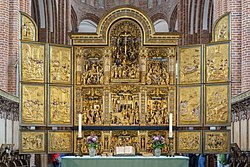 The altar
The altarIt has been accepted, that soon after he became Bishop of Roskilde in 1157, Absalon began to expand the travertine cathedral.[8] In 1160, the art of firing bricks was brought to Denmark from Italy by monks, and the new material was employed. Researchers decided to build a new cathedral around the existing one, allowing services to continue during construction. It has long been believed that bishop Absalon began construction, and when Absalon was forced to surrender his position as Bishop of Roskilde in 1191, only the two floors of the apse, the choir towers and part of the transept had been completed.[9] Absalon's successor, Peder Sunesen, embracing the new French Gothic style, later made significant changes to the plans, tearing down the choir towers and reducing the width of the transept.[10] But new research points to Peder Sunesen as the main initiator and hence instead of rebuilding it, it was constructed in the transition period between Romanesque and Gothic show elements from both styles in the cathedral.
The choir was completed and inaugurated in 1225, allowing services to begin there, and the old travertine cathedral was torn down. Work on the nave continued for the next 55 years, limited by funds, lack of kilns to fire the bricks, and the winters.[11] With the exception of the two towers on the west facade, the cathedral was completed by 1280, and work on the interior proceeded, slowed by a fire in 1282 which also destroyed several of the canons' houses in the area. Several chapels were also added to the cathedral, and in 1405, work on the towers was completed.
 Sarcophagus of Scandinavian Queen Margrethe I.
Sarcophagus of Scandinavian Queen Margrethe I.When Margrethe I died in 1412, she was buried in her family's chapel at Sorø Klosterkirke. But the following year bishop Peder Jensen Lodehat, who had been the queen's chancellor and religious advisor, brought her body to Roskilde Cathedral. The monks in Sorø were outraged, above all because the loss of the queen's earthly remains would mean a significant loss in income from requiems — at that time monks and clergy would typically have been paid to say requiem masses for a dead person, and for a queen such masses would likely have been said on a regular basis in perpetuity, each one incurring a fee — as well as a loss of prestige. Though often blamed on the bishop, it is quite possible that the move was orchestrated by the queen's adoptive son, Eric of Pomerania. This is reinforced by the inscription on the sarcophagus, which describes how it was given by the new king, Eric VII, in 1423.
In his "Chronica novella", German chronicler de:Hermann Korner describes the vast, three-day-long burial ceremony involving King Eric VII, several noblemen, the Archbishop of Lund, and all of the Danish bishops. There is an account of how the procession granted substantial gifts to each of the 50 altars in the cathedral. On the first day, the royal couple would give each altar a golden ornament, a golden antependium and a silver chalice; the noblemen would each bestow a florin on the altars; and the knights, squires, and anyone else who wished to bestow gifts would provide each altar with silver coins from Lübeck. On the second and third days, the royal couple would bestow two nobles on each altar, the noblemen would bestow a florin on them, and the rest of the procession would bestow silver coins as they wished. What was left of silver coins were then put in a bowl, to be cast among the poor in Roskilde?
On 14 May 1443, a fire swept through Roskilde, destroying most of the city and all but three of the clergy's houses. The fire was so intense that the glass windows cracked, and the lead roofing melted. The cathedral was badly damaged and it was not until 1463 that the bishop, Oluf Mortensen, could rededicate it. To help with its reconstruction, the bishops of Denmark each signed a letter granting 40 days of indulgence to whoever would contribute to its cost.[12] The reconstruction could also have been helped by the decision of Christian I to build a chapel at the cathedral. The Chapel of the Magi was built during the 1460s, and together with the sarcophagus of Margrethe I and the remains from the previous churches, it marks the earliest royal burials.
The Reformation arrived in 1536, marking a sharp negative turn for Roskilde Cathedral. Not only was the Bishop of Roskilde, Joachim Rønnow, jailed in Copenhagen Castle, the diocese was moved to Copenhagen and Peder Palladius, became the new Superintendent of Zealand and later a bishop. Hans Tausen, who had sought to encourage wide adoption of the Reformation, was sent to Roskilde in 1538 to help convert the clergymen who were opposed to the new ideas. At a Reformation meeting in 1540, it was decided that all of the bishop's property was now to belong to the king, both symbolically and in reality the head of the Church of Denmark. The cathedral had already been forced to hand over some of its property during the Count's Feud, but following the decision and with an impending war against the Swedes, the confiscation of church property was stepped up. Among the cathedral's most prized possessions was a wooden statue of St Lucius, covered in gold and gems. The chapter fought hard to try and retain its property, at one point asking for a receipt for some of the confiscated goods, to which the king's men replied that the king did not need to hand out a receipt for something that already belonged to him.[13]
 The nave of the cathedral
The nave of the cathedralAfter the Reformation, the cathedral was opened up to the ordinary congregation, necessitating the purchase of new furniture, especially pews. As in other former Catholic cathedrals, the choir, which had been separated from the nave by a large wall, was left intact with the altar placed against the wall.
While the cathedral suffered financial hardship, having been forced to give away all its property (which at the time included one in every four farms on Zealand and 30 large estates), it was endowed with a variety of gifts from Christian IV: The altarpiece (between 1555 and 1623), a royal box ca 1600, the pulpit in 1610, his own burial chapel in 1614, the construction of the iconic twin spires in 1633 and finally a grand Renaissance sandstone entrance portal in 1635.[14]
On 26 February 1658, the Treaty of Roskilde was signed in the cathedral. In the loot the Swedes took from the cathedral, was the golden dress of Margrethe I, which had hung in a closet near her sarcophagus. The dress was taken by the Swedish queen consort Hedwig Eleonora and is now located at Uppsala Cathedral. In 1690, Christian V ordered the old Catholic choir cleared, so he could create a crypt beneath it for the children he had had with his mistress Sophie Amalie. This also allowed for the altar to be moved to its present position.
In 1774, work on the third royal burial chapel, Frederick V's chapel, began with the removal of the pre-existing Chapel of Our Lady. Money soon ran out, and it was not until 1825 that the work was completed. In the meantime, in 1806, the cathedral sold its inventory from its Catholic days at a notorious auction. Among the items sold was a grand crucifix which went to a local coppersmith. While he was sawing the crucifix into firewood, the head of Jesus split open and a small, golden patriarchal cross fell out. Upon closer inspection, it was revealed that the cross was hollow and that a splinter from Christ's cross was hidden inside. Rumour of the find quickly reached the Royal Art Collection, later the National Museum of Denmark, which immediately purchased it.[15]
In 1871, the entrance portal was replaced with one that matched the rest of the cathedral, while the old portal was donated to Holmen Church. However, when the new portal arrived, the churchwarden was horrified to see it was a poor copy of the old style. But he had no choice but to erect it.[14]
Work on the fourth royal burial chapel began in 1915, and prior to its completion in 1924, Roskilde was once again made a diocese. On 27 August 1968, as restoration work on the Margrethe spire was nearing completion, the spire burned, threatening to collapse into the choir. During firefighting operations, members of the civil defense and church staff covered the canons' chairs, the altar, and the sarcophagi in the retrochoir with damp fire blankets, hoping to prevent damage to the invaluable items. The Defence Minister of Denmark ordered a complete ban on jet operations in the area, pending investigations into whether the vaults were in danger of collapsing.[16] It was later discovered, that despite a total ban on any heat sources in the area where the restoration was taking place, the craftsmen had been smoking and using blowtorches in the loft.[17] The latest addition to the cathedral was in 1985, when the New Burial Ground, also known as Frederik IX's Burial Ground, was inaugurated.
In 2018, the future resting place and monument for the current queen of Denmark Queen Margrethe II were placed in the chapel of St. Brigitte.[18] The design is made by a Danish sculptor Bjørn Nørgaard. A model is at display in the cathedral alongside an exhibition on the tradition of royal burials.[19]
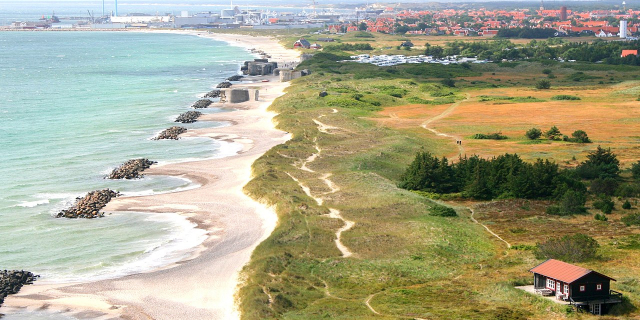

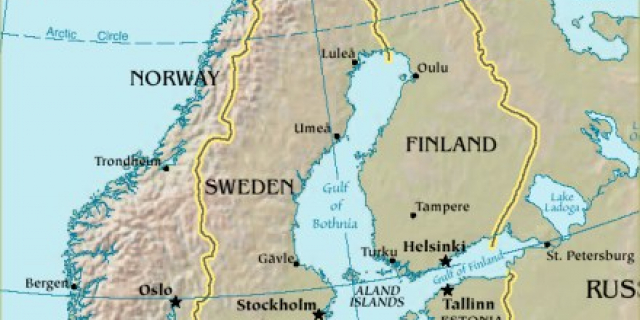

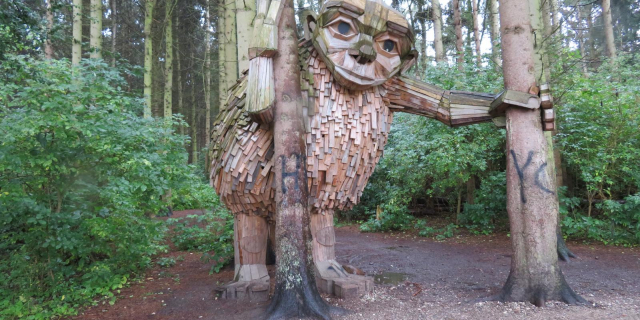





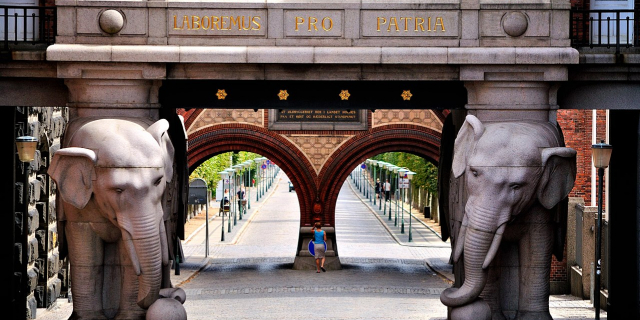
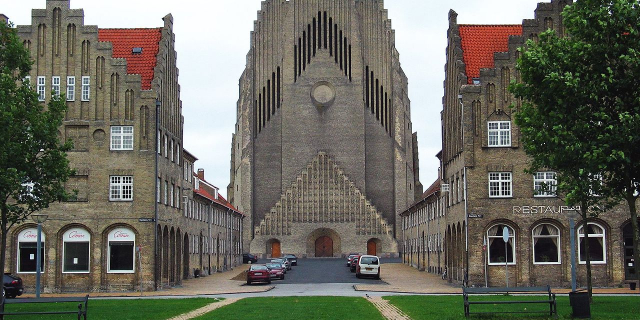

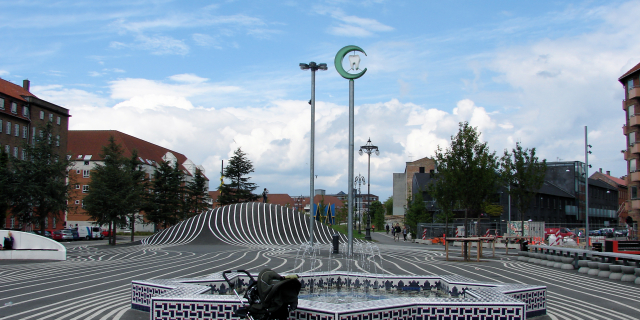

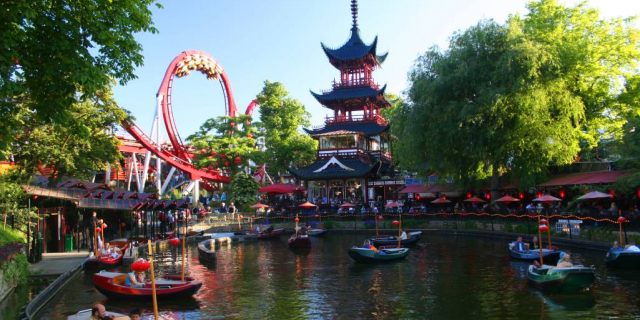

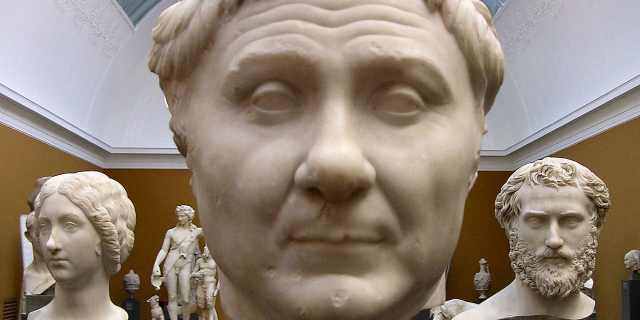

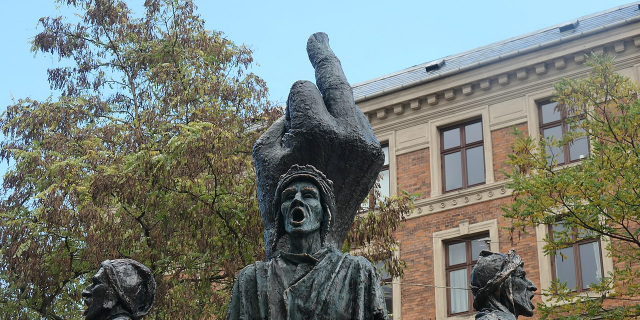


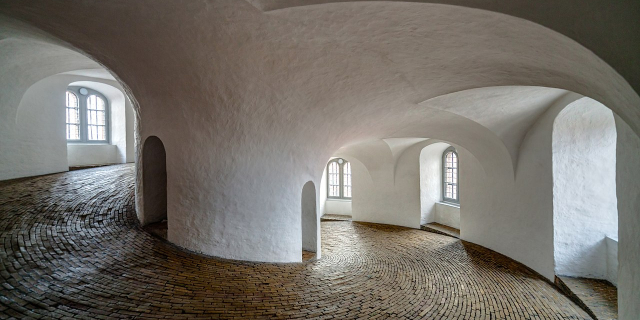

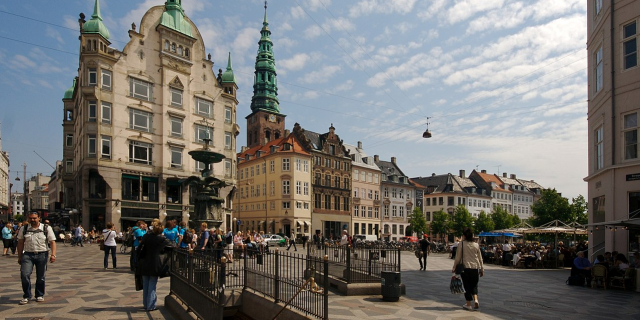



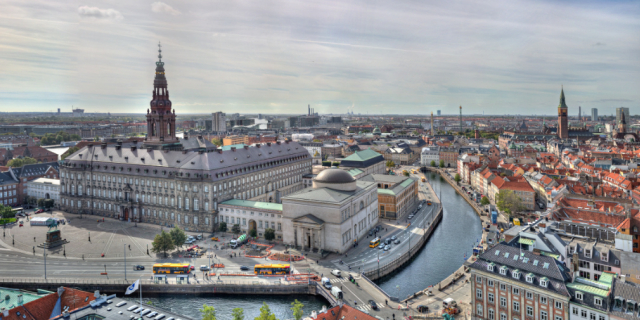
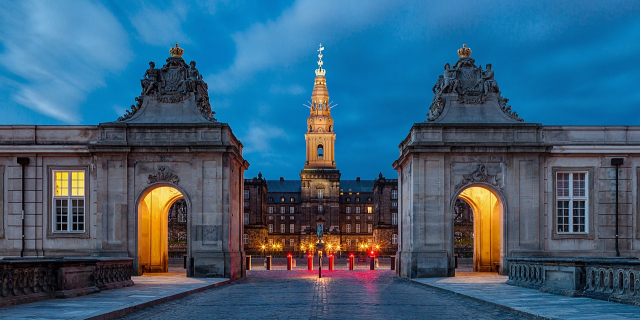




Add new comment